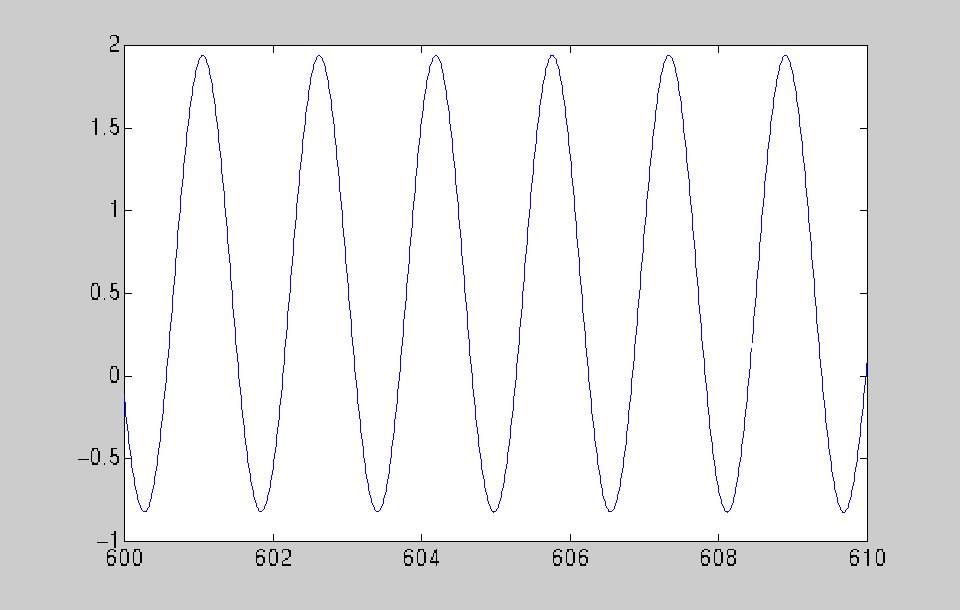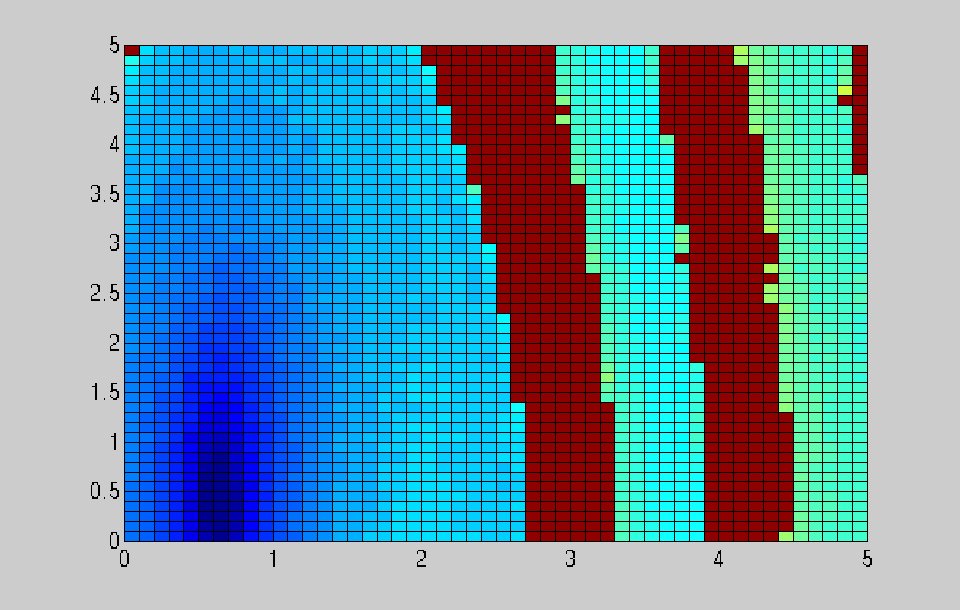Tacoma Narrows Bridge
Due:
Your report must be
submitted by 9:30 a.m. on Tuesday, December 5.
Group project:
Your group is limited to at most four members.
Once a group begins work on the project, its membership cannot
change. Consequently establishing your group must be your first step
in this project. Each group will submit one report, and all members of
the group will receive the same grade for this project.
Goals:
- To become familiar with the long-term behavior of solutions
to certain forced second-order equations.
- To study the relationship between the frequency of the
forcing and the amplitude of the solutions.
Second-order equations:
Using all of the methods that we have developed in this course, you
will analyze the long-term behavior of the solutions to two similar
forced, second-order equations.
We begin with the forced harmonic oscillator
x" + bx' + k1x = cos wt.
Here b is the damping coefficient,
k1 is the spring constant,
and w determines the frequency
of the forcing.
-
(An undamped, forced linear equation)
First consider the equation in the case where b=0.
Using the Method of the Lucky Guess, determine a particular solution
to the equation. Then using a numerical solver and/or the formulae
for the solutions, estimate the amplitudes of the
solutions for
frequencies w in the interval 0 <= w <= 5.
How do the
amplitudes in the nonresonant case relate to the amplitudes in the
resonant case?
-
(Damped, forced linear equations) Assume that the forcing is
present along with some damping (b>0).
How long does it take any
given solution to get close to the steady-state solution? Using a
numerical solver and/or the formulae for the solutions,
estimate the maximum amplitudes of the solutions for
frequencies w in the interval
0 <= w <= 5 for various
values of b.
Graph the maximum amplitude as a function of
frequency for different values of b, all on the same
set of axes. What happens to these graphs as
b -> 0?
Now we return to the mass-spring system with a rubber band that we
studied in the first
project. Recall that the differential equation for that autonomous
(unforced) system is
y" + by' + k1y + k2y+ = 10
(see Project #1 for an explanation of the
notation).
We will use this differential equation as a (very simplified) model of
the Tacoma Narrows Bridge (see Section 4.5 in our text).
Pictures of the current bridge and
movies of the collapse of the original Tacoma Narrows Bridge,
Galloping Gertie,
are available on the web from the
Washington State government
and the
College of Engineering
at Iowa State University.
We now introduce a term of the form A sin wt to
model a periodic external
force, presumably caused by the wind in Tacoma Narrows,
and we obtain the forced
equation
y" + by' + k1y + k2y+ = 10 + A sin wt
For the remainder of this
project, we will assume that b=0.01, A=0.1, and
w=4.
-
(small amplitude periodic solution)
Using analytic techniques as in Part 1, calculate a periodic solution
that has small amplitude, and use a numerical differential equations
solver to verify your calculation. Provide illustrations of
its y(t)-graph and its
solution curve in the phase plane. What are the initial conditions
for this solution?
-
(large amplitude periodic solution) This system also has a large
amplitude periodic solution that "attracts" many other solutions just
as the small amplitude periodic solution attracts many solutions.
 |
| |
The graph at the left is the graph of the large amplitude periodic
solution for values of k1 and k2
that are close to (but not the same as) the values that you are using.
|
Use
a numerical solver to find this solution and provide illustrations of
its y(t)-graph and its solution curve in the phase plane.
What are its initial conditions? Describe the process that you used to
locate the large amplitude periodic solution.
Please note:
This part of the project is difficult because it takes a long time
(often 1000 units of time) for typical solutions to settle down to
either the small amplitude solution or the large amplitude
solution. In addition,
it is difficult to find initial conditions that lead to the large
amplitude solution without doing a little bit of programming.
I found the initial conditions for the large amplitude solution
graphed above by taking a modest sized grid of initial conditions in
the 0 <= y <= 5 and 0 <= y' <= 5 square in the phase
plane, and then I used MATLAB's ode45 to produce an approximate
solution for each initial condition. The results can best be expressed
in the form of the figure such as:

The blue grid points represent initial conditions that produced
solutions that are eventually asymptotic to the small amplitude
solution. The red grid points represent initial conditions that came
nowhere near the the small amplitude solution for 0<=t<=1000.
It is a little tricky to use a computer to tell if you have found a
periodic solution, but for this equation you can take advantage of the
fact that the equation is periodic in t with period
pi/2. So if a solution goes for pi/2 units of time and
ends up back at the same initial condition, then the solution has to
be periodic. (Why? This point of view is discussed on pp.477-484 of
our text.)
It took 10 hours of computer time for me to generate the grid shown
above, and I do not really expect you to be able to produce such a
figure for your equation. (However, it would be very impressed if you
did.) In any case, just thinking about what that figure says should
help you come up with a strategy for locating the large amplitude
periodic solution.
Your report:
Your report should be no longer than five typewritten pages, and
it should address all of the questions mentioned above.
You may provide as many
illustrations from the computer as you wish, but the relevance of each
illustration to your report must be evident. Illustrations are not
included in the five-page limit. (Please remember that,
although one good illustration may be worth 1000 words, 1000
illustrations are worth nothing.)
Please insert your illustrations at appropriate places in your
report rather than attaching them to the end of the report.
Examples of good reports done here
at BU in previous semesters are available for inspection in my office.
Numerical simulation:
Be aware of the fact that pplane cannot handle nonautonomous
systems.
Therefore, you must use one of MATLAB's built-in ode solvers when you
analyze the solutions to these equations numerically. Note my FAQ
answer regarding the format of MATLAB files that define systems of
differential equations.
Parameter values:
The values of k1 and k2 that
you should
use are determined by the last digits of the BU ID numbers of the
members of your group. Use k1 = 12 + 0.1 a
and k2 = 5 - 0.05 a
where a is the average
(accurate to two decimal places) of the
last digits of all members in the group. For example, if the last
digits are 0, 1, 2, and 2,
then a = 1.25, k1 = 12.12, and
k2 = 4.94.
Academic Conduct:
Your work and conduct in this course are governed by the CAS Academic
Conduct Code. This code is designed to promote high standards of
academic honesty and integrity as well as fairness. Copies of the
code are available in CAS Room 105, and it is your responsibility to
know and follow the provisions of that code. In particular, all work
that you submit in this course must be your original work. For
example, the computations that you do for your report as well as the
text of your report must be original to your group. All group members
are responsible for all aspects of the report. Any cases of suspected
academic misconduct will be referred to the CAS Student Academic
Conduct Committee.

